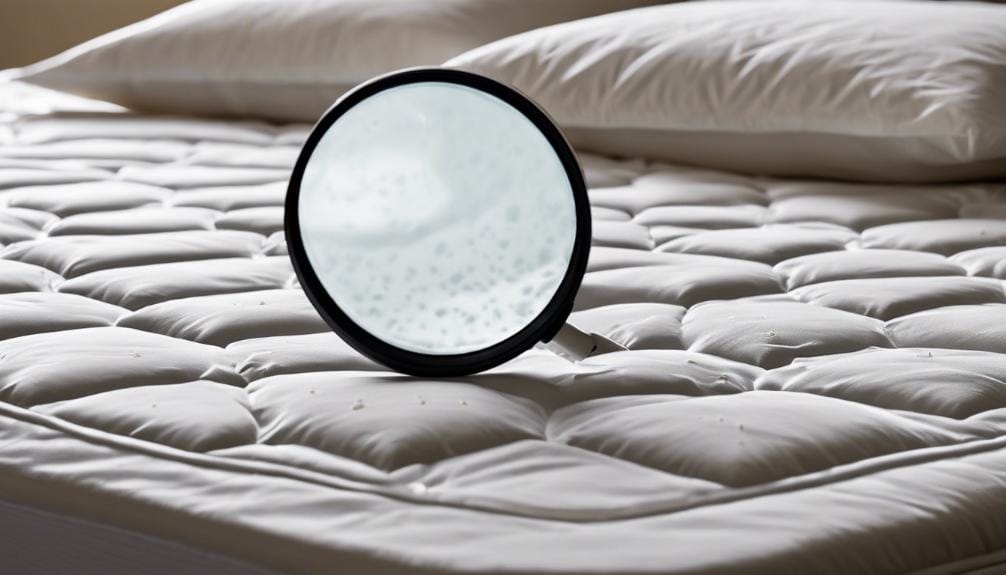Can Mattress Protector Be Washed? How to Do It Right
You might wonder if your mattress protector can be washed, and the answer is yes. However, it’s vital to know the right way to do it to guarantee it lasts. Start by checking the care label for specific instructions, as different materials may have different requirements. After that, you’ll want to follow a gentle washing process to keep it in prime condition. But what happens if you neglect to wash it regularly, or if you toss it in the dryer without a second thought? The implications might surprise you.
Can You Wash a Mattress Protector?

Yes, you can—and should—wash a mattress protector regularly to keep your sleep environment clean and healthy. Most mattress protectors are machine-washable, making it easy to add them to your regular laundry routine.
Check the care label for specific instructions, as different materials may have unique washing requirements. Regular cleaning helps maintain its effectiveness against allergens and pests, which reduces the presence of dust mites and allergens for a healthier sleep space.
Aim to wash your mattress protector at least every few months. If you have allergies or pets, consider washing it more often. This routine helps get rid of dust mites, allergens, and other unwanted invaders that could impact your sleep quality.
Using your washing machine makes the task simple. Remember to choose the right settings based on the material. Some protectors have waterproof layers that need gentle care, while others can handle warmer temperatures.
How to Wash a Mattress Protector?
To wash your mattress protector effectively, first, check the care label for specific instructions based on the material. This is crucial because different protectors require different care, especially ones with a waterproof layer that can be damaged by high temperatures.
Regular cleaning is vital for maintaining hygiene and extending the life of your mattress protector, which acts as a barrier against dirt and allergens.
Next, remove any bedding and place the mattress protector in your washing machine. Use a gentle cycle with cold or warm water, depending on the care instructions. A mild detergent will help clean without damaging the protective features.
After the wash cycle is done, check for any remaining stains. If you find any, treat them before washing again. Aim to wash your mattress protector at least every few months, or more often if you have pets or allergies.
For drying, air drying is best to preserve the protector’s integrity. If you use a dryer, choose a low heat setting to protect the waterproof layer.
Following these steps will keep your mattress protector in great shape, ensuring a clean and healthy sleeping environment.
Can Mattress Protectors Go in the Dryer?

Wondering if you can toss your mattress protector in the dryer after washing it? The short answer is yes, but proceed with care. Most mattress protectors can handle dryer use, but always check the care label first.
Protectors with waterproof layers can be heat-sensitive, so it’s best to use a low heat setting. This ensures thorough drying without damaging the material. Keeping your mattress protector clean is crucial for hygiene and prolonging its lifespan, which ultimately means a more comfortable sleep environment.
Avoid using fabric softeners in the dryer, as they can break down the waterproof features of your protector. Also, take it out of the dryer promptly to prevent wrinkles and help it keep its shape.
If you’re hesitant about using the dryer, air-drying is a safe and effective alternative. This method helps maintain the integrity of the mattress protector. Keeping your mattress protector in good condition not only extends its usability but also ensures it continues to shield your mattress effectively.
How Often Should You Wash a Mattress Protector?
Washing your mattress protector might seem like a chore, but it’s essential for keeping your sleep environment clean and healthy.
Regular laundering not only keeps it hygienic but also preserves its ability to block bacteria and dust mites.
So, how often should you wash it? Experts suggest at least once every few months, but this can vary based on your lifestyle.
Here’s a quick guide:
- Every 1-3 months: This general frequency works for most people.
- Every month: If you have allergies, monthly washing helps reduce allergens.
- Every 2 weeks: Pet owners should wash it every two weeks to maintain a cleaner sleep space.
- After spills or accidents: Always wash immediately to keep its protective features intact.
Regular washing removes dust mites, allergens, and other irritants, contributing to a healthier sleep environment.
This simple task not only extends the life of your mattress protector but also improves your sleep quality.
A little effort goes a long way in supporting your overall well-being.
What Happens If You Don’t Wash Your Mattress Protector?

Not washing your mattress protector can lead to a buildup of allergens, dust mites, and bacteria. This not only affects your sleep quality but also your overall hygiene. Every night, you could be lying on a surface that’s swarming with harmful invaders.
Here’s a quick rundown of what can happen:
| Consequence | Description | Impact on You |
|---|---|---|
| Allergens | Pollen, pet dander, and mold accumulate. | Triggers allergies and asthma. |
| Dust Mites | Tiny pests thrive in unwashed fabrics. | Causes itchiness and discomfort. |
| Bacteria | Sweat and bodily fluids foster bacteria growth. | Increases risk of skin infections. |
| Poor Hygiene | Dirty protectors create an unhealthy sleep area. | Affects your overall well-being. |
| Reduced Sleep Quality | An uncomfortable sleeping environment disrupts rest. | Leads to fatigue and irritability. |
Failing to clean your mattress protector can leave you exposed to these issues, disrupting not just your sleep but your daily life. Regular washing is essential for maintaining a clean and healthy sleeping environment.
Frequently Asked Questions
What Specific Materials Are Mattress Protectors Made From?
Mattress protectors typically come in materials like cotton, polyester, and vinyl. Each offers different benefits, such as breathability, waterproofing, or softness. You’ll want to choose one that suits your comfort and protection needs best.
Can I Use Bleach on My Mattress Protector?
You shouldn’t use bleach on your mattress protector. It can damage the fabric and reduce its effectiveness. Instead, opt for gentle detergents to keep it clean while preserving its protective qualities and longevity.
Will Washing Affect the Waterproof Layer?
Washing won’t necessarily damage the waterproof layer if you follow care instructions. Use gentle cycles, avoid high heat, and consider air-drying. This way, you maintain its protective features while keeping it clean and fresh.
How Do I Remove Stains From My Mattress Protector?
To remove stains from your mattress protector, blot the area with a mixture of mild detergent and water. Rinse gently, then let it air dry completely to avoid damaging any waterproof layers or fabric.
Are There Any Mattress Protectors That Are Hand Wash Only?
Yes, some mattress protectors require hand washing only, especially those made from delicate materials. Always check the care label for specific instructions to keep your protector in top condition and extend its lifespan.
In Conclusion
To sum up, yes, you can wash your mattress protector, and doing it right keeps your sleeping space fresh and clean. Just remember to check the care label, use a gentle cycle with mild detergent, and treat any stains before drying. Regularly washing your protector helps maintain its quality and hygiene, ensuring a better night’s sleep. Don’t underestimate the importance of this simple step—your mattress will thank you for it!
